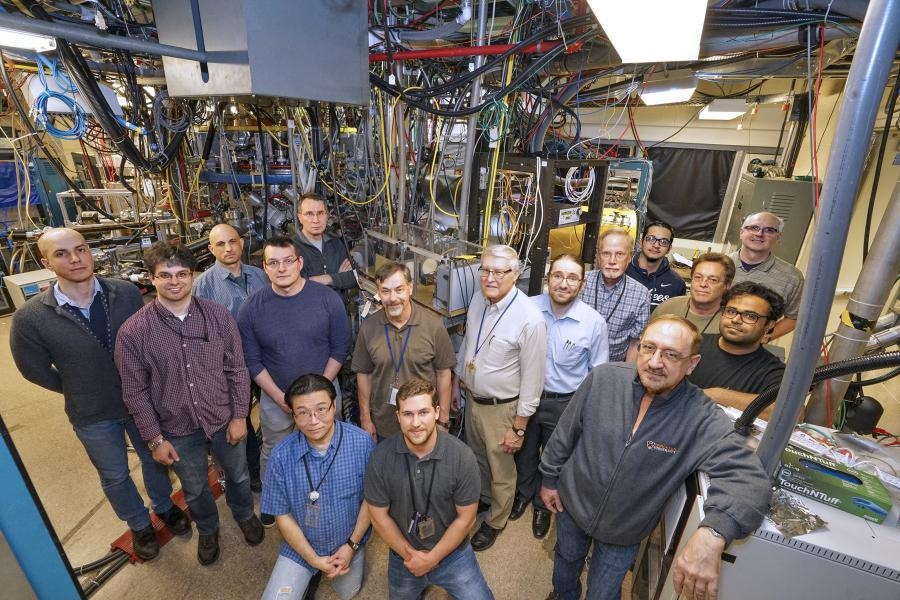May 2 2019
Lithium is a light silvery metal that is utilized in many products, ranging from batteries that power electric cars and smartphones through to pharmaceutical applications.
 The team that upgraded the LTX-β. Front row from left: Shigeyuki Kubota, Dylan Corl, Guy Rossi, Anurag Maan (behind Rossi). Second row from left: Filippo Scotti, Dennis Boyle, Drew Elliott, Dick Majeski, Tom Kozub, Paul Hughes, Ron Bell (behind Hughes), Kristopher Gilton. Third row from left: John Armeli, Vsevolod Soukhanovskii, Fredy Rabanales, Peter Sloboda. (Image credit: Princeton Plasma Physics Laboratory)
The team that upgraded the LTX-β. Front row from left: Shigeyuki Kubota, Dylan Corl, Guy Rossi, Anurag Maan (behind Rossi). Second row from left: Filippo Scotti, Dennis Boyle, Drew Elliott, Dick Majeski, Tom Kozub, Paul Hughes, Ron Bell (behind Hughes), Kristopher Gilton. Third row from left: John Armeli, Vsevolod Soukhanovskii, Fredy Rabanales, Peter Sloboda. (Image credit: Princeton Plasma Physics Laboratory)
Now, this metal could also aid in harnessing the Earth’s fusion energy that illuminates the stars and sun. Lithium is capable of maintaining the heat and safeguarding the walls within tokamaks that are shaped like doughnuts and accommodate fusion reactions, and this metal will be utilized to generate the hydrogen isotope— tritium—that will fuel fusion in upcoming reactors by combining with its cousin, deuterium.
A research team at the U.S. Department of Energy’s (DOE) Princeton Plasma Physics Laboratory (PPPL) has concluded a three-year upgrade of the Lithium Tokamak Experiment—currently known as the Lithium Tokamak Experiment-Beta (LTX-β)—a special device that will test the metal’s capacity to preserve the heat and safeguard the walls of the tokamak, which is presently more powerful.
Neutral beam injector
Funded by the DOE Office of Science, the upgrade setup a neutral beam injector—on long-term loan from Tri Alpha Energy, currently called TAE Technologies—in order to heat, fuel, and boost the plasma’s density. Other enhancements include an increased magnetic field that limits the plasma, and also installation of novel lithium systems. These enhancements bring conditions in the experiment nearer to those in a fusion reactor, stated principal investigator of the experiment Dick Majeski.
Before the upgrade, the new device, which utilized a lithium coating to cover the inner wall of the tiny tokamak, was the first to keep the temperature steady from the hot, middle core of the plasma to the usually cool outer edge. “The machine is now ready to exploit the full capability of the upgrade,” stated Phil Efthimion, head of PPPL’s Plasma Science and Technology unit, which supervises the experiment.
Light elements are integrated by fusion in the form of plasma—the hot and charged state of matter made up of atomic nuclei and free electrons—that produces vast amounts of energy. Investigators are looking to simulate fusion on Earth for an almost unlimited supply of power to produce electricity.
In order to complete the upgrade, the researchers created 500 kW of neutral beam power and, at the same time, they boosted the strength of the magnetic field that limits the plasma by two-thirds and also used a lithium coating to cover the tokamak walls; stray plasma particles are absorbed by the apparently magic metal, making sure that they do not bounce back into the middle of the plasma and cool it down. In addition, the researchers increased the neutral beam power to more than 600 kW, boosting the machine’s heating power by a factor of 10.
Still maintain good confinement?
The subsequent test is whether the machine that has been upgraded is capable of maintaining constant temperature and excellent confinement in relatively hotter plasmas, with more powerful magnetic fields. The beam upgrade will ensure that the density does not drop and show whether more energetic and hotter plasma can still be regulated.
Upgrade construction required steps that involved installation of a new lithium evaporator and a more robust power supply. It was “a difficult task to accomplish,” Majeski stated. “Everyone worked very hard. We got a lot of help from the laboratory’s NSTX-U [National Spherical Torus Experiment-Upgrade] engineering team.” The engineering effort was supervised by Tom Kozub, and physicist Dennis Boyle ran the device after it fulfilled the operating requirements.
Researchers from eight research centers across the country collaborated on the LTX-β study: Princeton University; Oak Ridge and Lawrence Livermore National Laboratories; University of Wisconsin-Madison; University of California, Los Angeles; University of Tennessee, Knoxvillel and University of Washington.